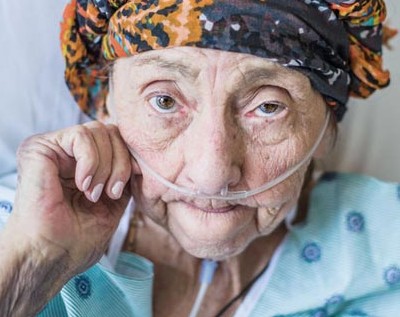Your Role in Hospice as the Attending Physician
You Are Part of the Care Team

If you refer your patient with advanced illness to VITAS® Healthcare and that patient designates you as their hospice attending physician, you can choose to support their plan of care and bill for the services you provide related to the patient’s terminal prognosis.
As the attending for a VITAS patient, you are an integral member of our interdisciplinary team. You know your patient well, which is why we actively collaborate with you to develop a customized plan of care for them. Throughout your patient’s hospice enrollment period, you can remain involved in direct patient care at the level and frequency you prefer.
The attending can be a doctor of medicine or osteopathy, a nurse practitioner,* or a physician assistant.*
Hospice Helps You and Your Patient
Hospice care with VITAS offers benefits to both you and your patient:
- Think of the VITAS interdisciplinary team as an extension of your care in the patient’s preferred care setting. You, your patient, and their caregivers benefit from the support of VITAS, which addresses your patient’s unique physical, spiritual, and psychosocial needs.
- Our interdisciplinary teams include a hospice physician, nurse, hospice aide, social worker, and chaplain. Your patient benefits from the comfort, dignity, and personalized care the team brings to the patient’s home.
- Our expanded teams ensure patients are receiving the highest level of symptom management and quality of life beyond the hospice benefit requirements, including respiratory therapy, dietary support, PT/OT/speech, music, pet visits, and massage.
- VITAS can help inform as well as implement your patient’s plan of care, honoring their care goals, wishes, and values.
The primary goal of hospice and palliative medicine is to manage symptoms and achieve quality of life for patients and families. The research bears this out: Hospice care—more specifically, earlier access to hospice care—is associated with better symptom relief, patient-goal attainment, and quality of care.
Enhancing Quality of Life for Patients, Families, and Caregivers
Recent research conducted by NORC at the University of Chicago (NORC) has revealed a positive correlation between increased hospice utilization within the final six months of life and elevated levels of care satisfaction and quality of life. NORC undertook a thorough examination aimed at appraising the efficacy of hospice care within the Medicare program and its stakeholders, including patients, families, and caregivers. Additional literature supports the NORC study’s findings:
Patients
- Patients admitted to hospice within the terminal six-month period reported heightened satisfaction levels, improved pain management, and decreased instances of hospitalization, culminating in diminished physical and emotional distress and an overall improved quality of life.1
Families
- Families of patients receiving hospice care for over 30 days reported the most positive outcomes.2,4
- They noted a heightened probability of patients' end-of-life preferences being honored and rated the quality of end-of-life care as excellent.2,4
- Implementation of home hospice care further mitigated the risk of prolonged grief disorder for families, facilitating tailored pain management interventions and dyspnea support for patients.3
Caregivers
- Caregivers reported a decreased incidence of post-traumatic stress disorder (PTSD) associated with home hospice deaths.3
These findings underscore the pivotal role of hospice care in improving the overall well-being of patients, families, and caregivers during the end of life.
Your role as an attending physician, nurse practitioner, or physician assistant allows you to be an integral part of a supportive network, ensuring that your patients receive comprehensive and compassionate care tailored to their unique needs and preferences.
By embracing hospice earlier in the care journey, we not only enhance the quality of life for those facing terminal illness but also bring support to families and caregivers.
Additionally, you can continue to be reimbursed for your patient encounters. The following modifiers are how you bill when you are the hospice attending of record:
Modifier Chart
| Modifier | Description |
|---|---|
| GV | Attending physician not employed or paid under agreement by the patient’s hospice provider; or hospice-employed nurse practitioner acting as attending physician
|
| GW | Service not related to the hospice patient’s terminal condition
|
Call 800.93.VITAS to refer today and learn more about the role of an attending physician.
*Nurse practitioners and physician assistants cannot certify or re-certify an individual as terminally ill. Only the medical director/hospice physician is required for recertifications.
**These modifiers are provided for informational purposes only without a guarantee of the correctness or completeness of the material presented. This does not constitute billing advice; healthcare professionals should always consult their own billing or revenue cycle management experts for confirmation of proper billing procedures.
1Kumar, P., et al. (2017). Family perspectives on hospice care experiences of patients with cancer. Journal of Clinical Oncology, 35(4), 432.
2Trella Health (2020). Quantifying Hospice’s End-of-Life Impact. Available at: https://www.trellahealth.com/portfolio_page/ quantifying-hospices-end-of-life-impact/
3Wright, et al. (2010). Place of death: correlations with quality of life of patients with cancer and predictors of bereaved caregivers' mental health. Journal of Clinical Oncology, 28(29), 4457.
4Kumar, et al. (2017). Family perspectives on hospice care experiences of patients with cancer. Journal of Clinical Oncology, 35(4), 432.
Upcoming Webinars for Healthcare Professionals

Check Hospice Guidelines
Get diagnosis-specific guidelines in our hospice eligibility reference guide.
Hospice Guidelines by Diagnosis Refer Your Patient
